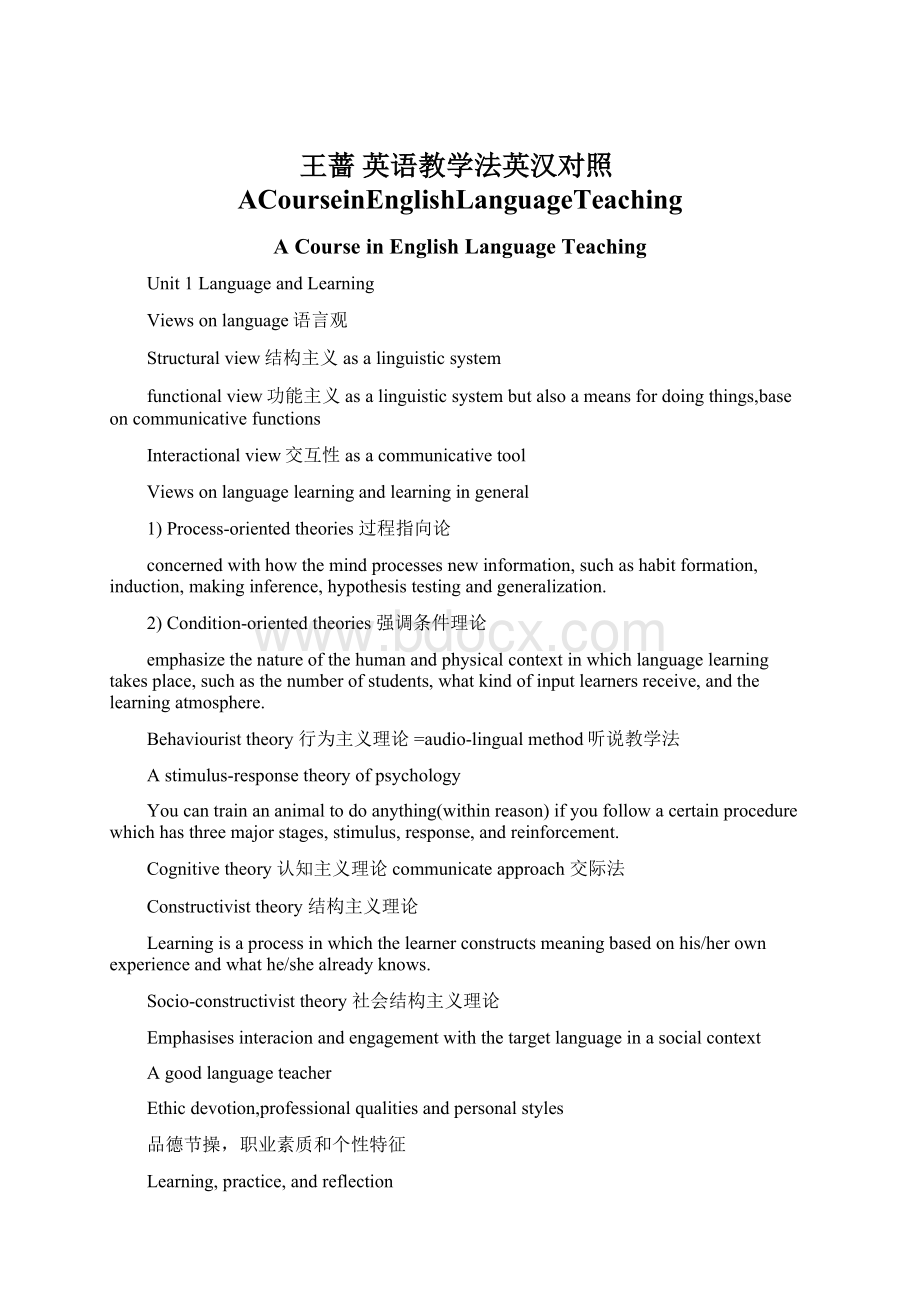王蔷 英语教学法英汉对照ACourseinEnglishLanguageTeaching.docx
《王蔷 英语教学法英汉对照ACourseinEnglishLanguageTeaching.docx》由会员分享,可在线阅读,更多相关《王蔷 英语教学法英汉对照ACourseinEnglishLanguageTeaching.docx(15页珍藏版)》请在冰豆网上搜索。

王蔷英语教学法英汉对照ACourseinEnglishLanguageTeaching
ACourseinEnglishLanguageTeaching
Unit1LanguageandLearning
Viewsonlanguage语言观
Structuralview结构主义asalinguisticsystem
functionalview功能主义asalinguisticsystembutalsoameansfordoingthings,baseoncommunicativefunctions
Interactionalview交互性asacommunicativetool
Viewsonlanguagelearningandlearningingeneral
1)Process-orientedtheories过程指向论
concernedwithhowthemindprocessesnewinformation,suchashabitformation,induction,makinginference,hypothesistestingandgeneralization.
2)Condition-orientedtheories强调条件理论
emphasizethenatureofthehumanandphysicalcontextinwhichlanguagelearningtakesplace,suchasthenumberofstudents,whatkindofinputlearnersreceive,andthelearningatmosphere.
Behaviouristtheory行为主义理论=audio-lingualmethod听说教学法
Astimulus-responsetheoryofpsychology
Youcantrainananimaltodoanything(withinreason)ifyoufollowacertainprocedurewhichhasthreemajorstages,stimulus,response,andreinforcement.
Cognitivetheory认知主义理论communicateapproach交际法
Constructivisttheory结构主义理论
Learningisaprocessinwhichthelearnerconstructsmeaningbasedonhis/herownexperienceandwhathe/shealreadyknows.
Socio-constructivisttheory社会结构主义理论
Emphasisesinteracionandengagementwiththetargetlanguageinasocialcontext
Agoodlanguageteacher
Ethicdevotion,professionalqualitiesandpersonalstyles
品德节操,职业素质和个性特征
Learning,practice,andreflection
Unit2CommunicativePrinciplesandActivities
CLT=CommunicativeLanguageTeaching交际语言教学法
TBLT=Task-basedLanguageTeaching任务型教学法
PPP=thePresentation,PracticeandProduction呈现,操练,展出
Communicativecompetence
Entailsknowingnotonlythelanguagecodeortheformoflanguage,butalsowhattosaytowhomandhowtosayitappropriatelyinanygivensituation
Fivemaincomponentsofcommunicativecompetence
Linguisticcompetence语言能力
Pragmaticcompetence语用能力
Discoursecompetence语篇能力
Strategiccompetence策略能力
Fluency语言顺畅
CLT
Goal:
todevelopstudents'communicativecompetence,whichincludesboththeknowledgeaboutthelanguageandtheknowledgeabouthowtousethelanguageappropriatelyincommunicativesituations.
Principles:
Communicativeprinciple
Taskprinciple
Meaningfulnessprinciple
Mainfeatures:
(1)Functionalcommunicativeactivities:
功能互动活动
Identifyingpictures
Discoveringidenticalpairs
Discoveringsequencesorlocations
Discoveringmissinginformation
Discoveringmissingfeatures
Discovering"secrets"
Communicatingpatternsandpictures
Communicativemodels
Discoveringdifferences
Followingdirections
Reconstructingstory-sequences
Poolinginformationtosolveaproblem
(2)Socialinteractionactivities:
社会交往活动
Role-playingthroughcueddialogues
Role-playingthroughcuesandinformation
Role-playingthroughsituationandgoals
Role-playingthroughdebateordiscussion
Large-scalesimulationactivities模仿
Improvisation即兴创作
Notes:
Nospecificactivitiesalmostaboutlisteningandspeaking
Sixcriteriaforevaluatinghowcommunicativeclassroomactivitiesare:
Communicativepurpose:
informationgap
Communicativedesire:
realneed
Content,notform:
message
Varietyoflanguage
Noteacherintervention干涉
Nomaterialscontrol
TBLT
Definition:
Referstoanapproachbasedontheuseoftaskasthecoreunitofinstructioninlanguage
TBLT:
pre-task,taskcycle,languagefocus
Definitionofatask:
Ataskisapieceofworkundertakenforoneselforforothers,freelyorforsomereward.
Fourcomponentsofatask:
Apurpose:
focusoncontent,notform
Acontext:
informationgap
Aprocess:
problemsolvingreasoning,inquiring,conceptualisingandcommunicating
Aproduct:
nocommunicationalresults
Exercises,exercise-tasksandtasks:
Focusonindividuallanguageitems
→purposeful&contextualisedcommunication
Exercise→exercise-task→task
Howtodesigntasks:
Thinkaboutstudents’needs,interests,andabilities
Brainstormpossibletasks
Evaluatethelist
Choosethelanguageitems
Preparingmaterials
PPPmodel
Atthepresentationstage:
Theteacherintroducesnewvocabularyandgrammaticalstructuresinwhateverwaysappropriate
Atthethepracticestage:
Thelessonmovesfromcontrolledpracticetoguidedpracticeandexploitationofthetextswhennecessary
Attheproductionstage:
Thestudentsareencouragedtousewhattheyhavelearnedandpractisedtoperformcommunicationtasks.
Notes:
Grammar-TranslationMethod:
语法翻译法
readingandwriting
TheAudio-LingualMethod:
听说教学法
speakingandlistening;dialoguesanddrills对话和操练
Unit3theNationalEnglishCurriculum课程标准
Itwasinthe1993syllablesthatthewordcommunicationwasusedintheobjectivesofteachingforthefirsttime.
TheSixDesignprinciplesfortheNationalEnglishCurriculumforNine-yearCompulsoryEducation:
1.Aimforeducatingallstudents,andemphasisequality-orientededucation面向全体学生,注重素质教育
2.Promotelearner-centredness,andrespectindividualdifferences突出学生主体,尊重个体差异
3.Developcompetence-basedobjectives,andallowflexibilityandadaptability整体设计目标,体现灵活开放
4.Paycloseattentiontothelearningpro-cess,andadvocateexperientiallearningandparticipation强调学习过程,倡导体验参与
5.Attachparticularimportancetoformativeassessment,andgivespecialattentiontothedevelopmentofcompetence注重过程评价,强调能力发展
6.Optimizelearningresources,andmaximiseopportunitiesforlearningandusingthelanguage开发课程资源,拓展学用渠道
FrameworkofobjectivesinthenewNationalEnglishCurriculum:
课程总目标
Overalllanguageability:
情感目标
语言目标
Learning学习策略
Affect情感态度
Cultural文化意识
能力目标
Language语言知识
Languageskills语言技能
Learning:
Cognitive;Selfmanagement;Communication;Resourcing
Affect:
International;Perspective;Patriotism;Confidence;Motivation
Cultural:
Knowledge;understanding;Awareness
Language:
Phonetics;Grammar;Vocabulary;Functions;Topics
Languageskills:
Listening;Speaking;Reading;Writing
ThedesignofthenewNationalEnglishCurriculum
Level1:
Grade3-4
Level2:
Grade5-6;basicrequirementsfor6thgraders
Graduatefromprimaryschool
Level3:
Grade7/Junior1
Level4:
Grade8/Junior2
Level5:
Grade9/Junior3
Graduatefromjuniorhighschool
AboveisduringCompulsoryEducation
Level6&Level7:
requiredofeveryseniorhighschoolstudents
2tracksofelectivecourse:
Track1:
level8&level9
Track2:
fromthebeginningofsenior1
Electivecourses:
Specializedskillcourses;ESPcourses应用类;Culturalandliterarystudiescourses欣赏类etc.
Unit4LessonPlanning
Alessonplan:
教案
Aframeworkofalessoninwhichteachersmakeadvancedecisionaboutwhattheyhopetoachieveandhowtheywouldliketoachieve.
Benefitsfromlessonplanning:
1)Aclearlessonplanmakestheteacherawareoftheaimsandlanguagecontentsofthelesson.
2)Italsohelpstheteachertodistinguishthevariousstagesofalessonandtoseetherelationshipbetweenthemsothatthelessoncanmovesmoothlyfromonestagetoanother.
3)Theteachercanalsothinkabouthowthestudentscanbefullyengagedinthelesson.
4)whenplanningthelesson,theteacheralsobecomesawareoftheteachingaidsthatareneeded.
5).Lessonplanninghelpsteacherstothinkabouttherelativevalueofdifferentactivitiesandhowmuchtimeshouldbespentonthem.
6)Theteachersoonlearntojudgelessonstagesandphaseswithgreateraccuracy.
7)Plansarealsoanaidtocontinuingimprovement.
8)Afterthelesson,theteachercanaddanevaluationtotheplan,identifyingthosepartswhichwentwellandthosewhichwerelesssuccessful.
Principlesforgoodlessonplanning:
Aim;Variety;Flexibility;Learnability;Linkage
目标性;多样性;灵活性;可学性;连接性
Twolevelsoflessonplanning:
macroplanningandmicroplanning
宏观备课和微观备课
Macroplanning:
planningoveralongerperiodoftime
Microplanning:
planningforaspecificunitoralesson
Thereisnoclearcutbetweenthesetwotypesofplanning.Microplaningshouldbebasedonmacroplanning,andmacroplaningisapttobe
modifiedaslessongoon.
Macroplanninginvolvesthefollowing:
Knowingabouttheprofession
Knowingabouttheinstitution
Knowingaboutthelearners
Knowingaboutthecurriculum/syllabus教学大纲
Knowingaboutthetextbook
Knowingabouttheobjectives
Componentsofalessonplan:
1.Backgroundinformation背景资料
2.Teachingaims:
教学目标
Languageobjectives;Abilityobjectives;Moralobjectives
3.Languagecontentsandskills语言的内容和技巧
Stagesandprocedures:
Greetings;Awarm-up;PPPmodel/TBLTmodel;Summary;Homework/Assignment
4.Teachingaids教学手段
5.Endoflessonsummary总结
6.Optionalactivitiesandassignments
7.Afterlessonreflection:
Feelingsaboutthelesson;students’performances;unexpectedincidents;surprisethings
Unit5ClassroomManagement
Theroleoftheteacher:
Beforetheclass:
Planner
Duringtheclass:
1Controller,2Assessor评估者,3Organizer,4Prompter敦促者,5Participant参与者,6Resource-provider
Aftertheclass:
Evaluator
Teacher’snewroles:
Facilitators促进者;guides;researchers
Themostcommonstudentsgroupings:
Wholeclasswork
Pairwork
Groupwork
Individualstudy
Harmer’ssuggestionsonmeasuresforindisciplinedactsandbadlybehavingStudents:
1)Actimmediately
2)Stoptheclass
3)Rearrangetheseats
4)Changetheactivity
5)TalktoSsafterclass
6)Usetheinstitution制度
InordernottohurttheStudents,Ur’sadviceonproblemsinclass:
1)Dealwithitquietly
2)Don’ttakethingspersonally对事不对人
3)Donotusethreats
Unit6TeachingPronunciation
Thegoalsofteachingpronunciation:
目的
Consistency连贯性:
Tobesmoothnatural
Intelligibility可理解性:
Tobeunderstandabletothelisteners
Communicativeefficiency交际效率性:
Tohelpconveythespeakers’meaning
Waysofpracticingsoundsandtheirdefinitions: